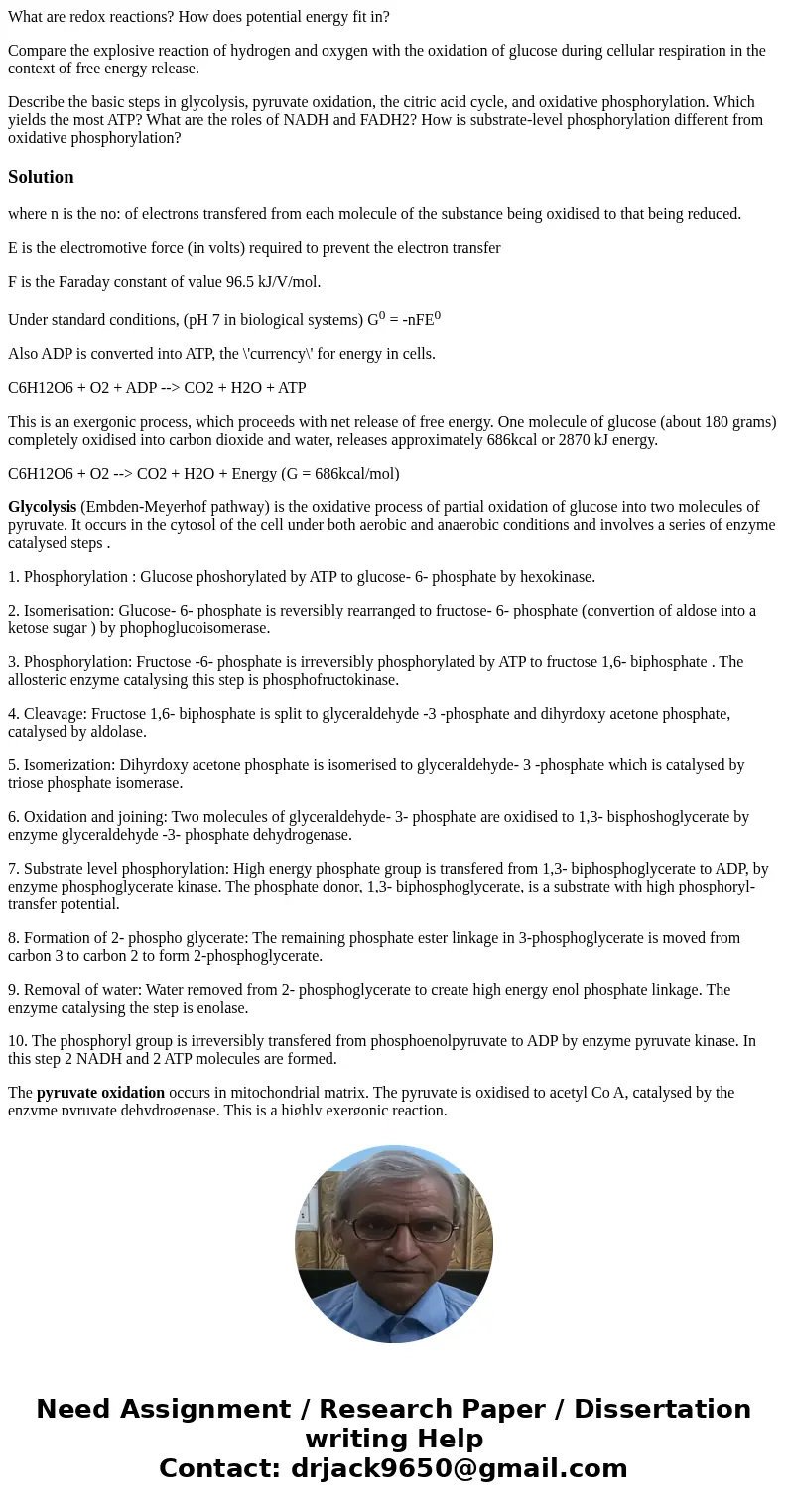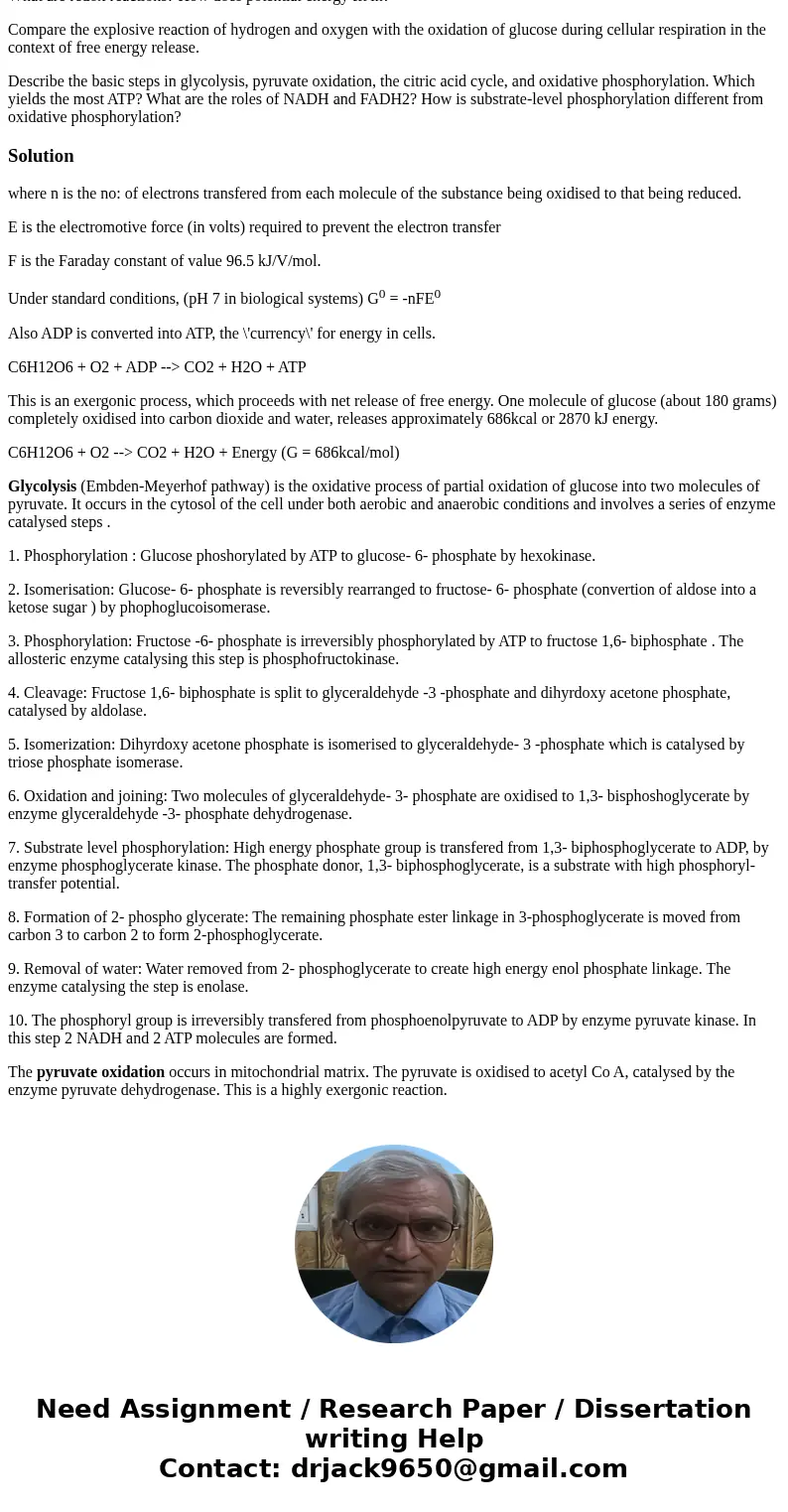What are redox reactions How does potential energy fit in Co
What are redox reactions? How does potential energy fit in?
Compare the explosive reaction of hydrogen and oxygen with the oxidation of glucose during cellular respiration in the context of free energy release.
Describe the basic steps in glycolysis, pyruvate oxidation, the citric acid cycle, and oxidative phosphorylation. Which yields the most ATP? What are the roles of NADH and FADH2? How is substrate-level phosphorylation different from oxidative phosphorylation?
Solution
where n is the no: of electrons transfered from each molecule of the substance being oxidised to that being reduced.
E is the electromotive force (in volts) required to prevent the electron transfer
F is the Faraday constant of value 96.5 kJ/V/mol.
Under standard conditions, (pH 7 in biological systems) G0 = -nFE0
Also ADP is converted into ATP, the \'currency\' for energy in cells.
C6H12O6 + O2 + ADP --> CO2 + H2O + ATP
This is an exergonic process, which proceeds with net release of free energy. One molecule of glucose (about 180 grams) completely oxidised into carbon dioxide and water, releases approximately 686kcal or 2870 kJ energy.
C6H12O6 + O2 --> CO2 + H2O + Energy (G = 686kcal/mol)
Glycolysis (Embden-Meyerhof pathway) is the oxidative process of partial oxidation of glucose into two molecules of pyruvate. It occurs in the cytosol of the cell under both aerobic and anaerobic conditions and involves a series of enzyme catalysed steps .
1. Phosphorylation : Glucose phoshorylated by ATP to glucose- 6- phosphate by hexokinase.
2. Isomerisation: Glucose- 6- phosphate is reversibly rearranged to fructose- 6- phosphate (convertion of aldose into a ketose sugar ) by phophoglucoisomerase.
3. Phosphorylation: Fructose -6- phosphate is irreversibly phosphorylated by ATP to fructose 1,6- biphosphate . The allosteric enzyme catalysing this step is phosphofructokinase.
4. Cleavage: Fructose 1,6- biphosphate is split to glyceraldehyde -3 -phosphate and dihyrdoxy acetone phosphate, catalysed by aldolase.
5. Isomerization: Dihyrdoxy acetone phosphate is isomerised to glyceraldehyde- 3 -phosphate which is catalysed by triose phosphate isomerase.
6. Oxidation and joining: Two molecules of glyceraldehyde- 3- phosphate are oxidised to 1,3- bisphoshoglycerate by enzyme glyceraldehyde -3- phosphate dehydrogenase.
7. Substrate level phosphorylation: High energy phosphate group is transfered from 1,3- biphosphoglycerate to ADP, by enzyme phosphoglycerate kinase. The phosphate donor, 1,3- biphosphoglycerate, is a substrate with high phosphoryl-transfer potential.
8. Formation of 2- phospho glycerate: The remaining phosphate ester linkage in 3-phosphoglycerate is moved from carbon 3 to carbon 2 to form 2-phosphoglycerate.
9. Removal of water: Water removed from 2- phosphoglycerate to create high energy enol phosphate linkage. The enzyme catalysing the step is enolase.
10. The phosphoryl group is irreversibly transfered from phosphoenolpyruvate to ADP by enzyme pyruvate kinase. In this step 2 NADH and 2 ATP molecules are formed.
The pyruvate oxidation occurs in mitochondrial matrix. The pyruvate is oxidised to acetyl Co A, catalysed by the enzyme pyruvate dehydrogenase. This is a highly exergonic reaction.


 Homework Sourse
Homework Sourse